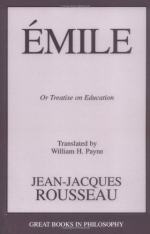Since the sun revolves round the earth it describes a circle, and every circle must have a centre; that we know already. This centre is invisible, it is in the middle of the earth, but we can mark out two opposite points on the earth’s surface which correspond to it. A skewer passed through the three points and prolonged to the sky at either end would represent the earth’s axis and the sun’s daily course. A round teetotum revolving on its point represents the sky turning on its axis, the two points of the teetotum are the two poles; the child will be delighted to find one of them, and I show him the tail of the Little bear. Here is a another game for the dark. Little by little we get to know the stars, and from this comes a wish to know the planets and observe the constellations.
We saw the sun rise at midsummer, we shall see it rise at Christmas or some other fine winter’s day; for you know we are no lie-a-beds and we enjoy the cold. I take care to make this second observation in the same place as the first, and if skilfully lead up to, one or other will certainly exclaim, “What a funny thing! The sun is not rising in the same place; here are our landmarks, but it is rising over there. So there is the summer east and the winter east, etc.” Young teacher, you are on the right track. These examples should show you how to teach the sphere without any difficulty, taking the earth for the earth and the sun for the sun.
As a general rule—never substitute the symbol for the thing signified, unless it is impossible to show the thing itself; for the child’s attention is so taken up with the symbol that he will forget what it signifies.
I consider the armillary sphere a clumsy disproportioned bit of apparatus. The confused circles and the strange figures described on it suggest witchcraft and frighten the child. The earth is too small, the circles too large and too numerous, some of them, the colures, for instance, are quite useless, and the thickness of the pasteboard gives them an appearance of solidity so that they are taken for circular masses having a real existence, and when you tell the child that these are imaginary circles, he does not know what he is looking at and is none the wiser.
We are unable to put ourselves in the child’s place, we fail to enter into his thoughts, we invest him with our own ideas, and while we are following our own chain of reasoning, we merely fill his head with errors and absurdities.
Should the method of studying science be analytic or synthetic? People dispute over this question, but it is not always necessary to choose between them. Sometimes the same experiments allow one to use both analysis and synthesis, and thus to guide the child by the method of instruction when he fancies he is only analysing. Then, by using both at once, each method confirms the results of the other. Starting from opposite ends, without thinking of following the same road, he will unexpectedly reach their meeting place and this will be a delightful surprise. For example, I would begin geography at both ends and add to the study of the earth’s revolution the measurement of its divisions, beginning at home. While the child is studying the sphere and is thus transported to the heavens, bring him back to the divisions of the globe and show him his own home.




